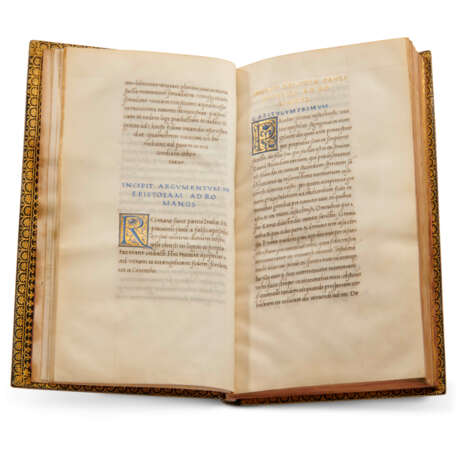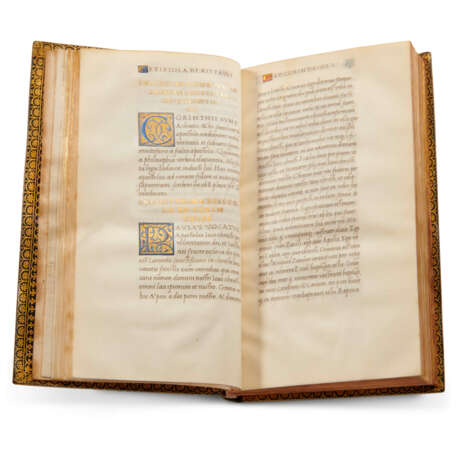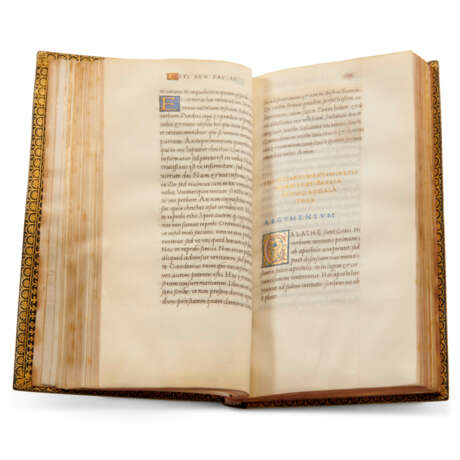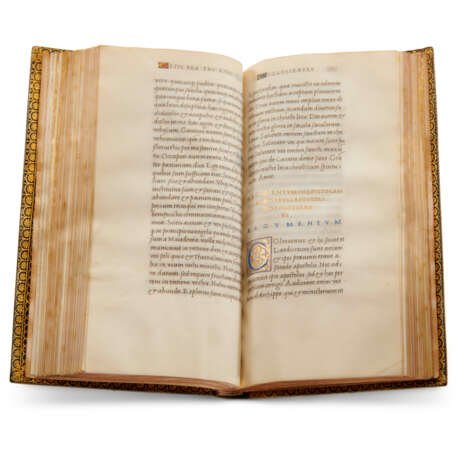ID 794435
Lot 38 | Anonymous French scribe of the Bellemare Group
Valeur estimée
£ 45 000 – 60 000
Pauline Epistles, with the prologues of pseudo-Jerome, in Latin, illuminated manuscript on vellum [Paris, c.1525]
A masterpiece of calligraphy by one of the most prominent of the Bellemare Group scribes, the present manuscript belongs to the same textual and stylistic family as two other Pauline Epistles of the same period: one at the Victoria and Albert Museum, and one at the Getty. Christopher de Hamel described it as 'one of the most exquisitely elegant biblical manuscripts of the renaissance'.
155 x 87mm. ii + 118 + ii leaves, complete, collation: 1-148, 156, old quire signatures in ink, 26 lines written in an exceptional calligraphic italic minuscule, ruled space: 104 x 48mm., headings in rustic capitals in burnished gold or blue, running titles in rustic capitals in black, line-fillers in gold on red and black grounds, small illuminated initials throughout, 30 large illuminated initials, added illuminated title page 'Divi / Pauli, Apostoli / Epistolae / Anno 1540', with vignette showing a fountain and landscape of trees and mountains, later marginal additions on f.54v (minor creasing of vellum and occasional marginal staining, else in excellent condition throughout). 18th-century French dark green morocco gilt, attributed to Derome, pink silk doublure and liners, gilt edges. Fitted black borocco pull-off case by Rivière & Son, title gilt.
Provenance:
(1) Robert Stayner Holford (1808-1892), acquired in c.1845; and his son, Sir George Holford (1860-1926): his sale, Sotheby's 29 July 1929, lot 5, to Quaritch; their Catalogue of Illuminated and Other Manuscripts, 1931, p.58, no 78, priced at £275.
(2) Estelle Doheny (1857-1958), her MS.6, bought through Alice Millard, 1932; presented to the Edward Laurence Doheny Memorial Library: their sale, Christie's, 2 December 1987, lot 173, to Kraus, for £27,000.
(3) J.R. Ritman (b.1941): his sale, Sotheby's, 6 July 2000, lot 55, for £58,000.
Content: Pauline Epistles, with the prefaces and prologues of pseudo-Jerome, ff.1-118v, beginning: 'Primum quaeritur [...]' (Stegmüller 670), followed by the prologue to Romans (f.3, Stegmüller 674) and the Argumentum (f.4v, Stegmüller 677) and Romans itself (f.5); continuing with I Corinthians (f.24v), II Corinthians (f.43v), Galatians (f.57), Ephesians (f.64), Philippians (f.71), Colossians (f.76), I Thessalonians (f.81), II Thessalonians (f.86), I Timothy (f.88v), II Timothy (f.94v) Titus (f.98v), Philemon (f.101), and Hebrews (f.102), all with prologues, ending on f.118v, '[...] omnibus vobis, Amen. Finis epistolarum divi Pauli Apostoli'.
Manuscripts of the Pauline Epistles with the preface, argument, and commentary of pseudo-Jerome date back to the 8th and 9th centuries, but they are rare in later centuries. By 1516 Erasmus had revealed that the prefaces and arguments were to be attributed to Pelagius, and not Jerome. The present manuscript, in using the pseudo-Jerome general preface and preface to Romans and Epistles arranged in Vulgate order is textually identical to two other Pauline Epistles of the same period: one in London (and written by the same scribe, Victoria and Albert Museum, MS L.1721-1921) and the splendid manuscript in Los Angeles after which the Master of the Getty Epistles is named (J. Paul Getty Museum, MS Ludwig I 15 [83.MA.64]). All three manuscripts originate with the same group of scribes and artists of the Bellemare Group, named for their association with Noël Bellemare, the Antwerp-trained painter under whose direction an entirely new style was introduced to French manuscript illumination in the second quarter of the 16th century. First identified by Dr Myra Orth – who named them the ‘1520s Hours Workshop’ – the atelier was responsible for illuminating at least 26 high quality manuscripts, dating from c.1522 until c.1551, the majority of these small-format Books of Hours written in a delicate humanistic script (on the three Pauline Epistles, including the present manuscript, see M. Orth, Renaissance Manuscripts: The Sixteenth Century, 2015, nos 46 and 50, and in particular pp.180-1).
Script: Most of the manuscripts produced by the Bellemare group are written in a similar, beautiful, calligraphic and sometimes slightly italicised hand, with the same decorated scroll initials throughout. The hand responsible for the present manuscript is particularly accomplished, and has in the past been attributed to Ludovico degli Arrighi (active 1510-26) and to Geofroy Tory (c.1480-1533). In addition to the V&A Pauline Epistles discussed above, Orth (Renaissance Manuscripts, p.168), links this script to a Bellemare Group Book of Hours made for Jean Lallemant the Younger (Baltimore, Walters Art Museum, MS W.446). Other manuscripts by the same scribe are apparently British Library Add. MS 35315, with miniatures by the Master of Claude de France, and Washington, Library of Congress MS.50 (see S. Schnutzer, Medieval and Renaissance Manuscript Books of Hours in the Library of Congress, I, 1989, p.xxxiii).
Special notice
No VAT on hammer price or buyer's premium.
| Lieu d'origine: | Europe de l'Ouest, France, Europe |
|---|---|
| Catégorie maison de vente aux enchères: | Manuscrits médiévaux et de la Renaissance |
| Lieu d'origine: | Europe de l'Ouest, France, Europe |
|---|---|
| Catégorie maison de vente aux enchères: | Manuscrits médiévaux et de la Renaissance |
| Adresse de l'enchère |
CHRISTIE'S 8 King Street, St. James's SW1Y 6QT London Royaume-Uni | |
|---|---|---|
| Aperçu |
| |
| Téléphone | +44 (0)20 7839 9060 | |
| Commission | see on Website | |
| Conditions d'utilisation | Conditions d'utilisation |






